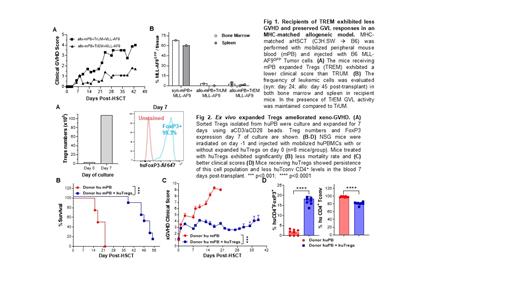Abstract
Mobilized hematopoietic stem / progenitor cells have become the primary option used for adult allogeneic hematopoietic stem cell transplants (aHSCTs) although GVHD remains a major immunologic complication (CIBMTR, 2017). The present studies are directed to developing a translational model for the application of donor regulatory T cells (Tregs) together with the use of mobilized peripheral blood (mPB) for more widespread application of these aHSCTs. We have previously reported that two-pathway Treg expansion strategy markedly elevates Treg numbers and function (Wolf, 2017; Copsel 2018). Additionally, this approach could be effectively applied in a concomitant strategy to amplify Treg suppressor activity in mPB to diminish pre-clinical GVHD (Barreras H, ASTCT Meeting S292 ,2019). Here, we present new findings using mPB transplants examining GVL reactivity in an MHC-matched minor antigen mismatched pre-clinical model and test the notion that human donor Tregs can be employed with mobilized healthy donor PB to effectively regulate xenogeneic GVHD.
Donor C3H.SW (H2b) mice were treated with filgrastim for 4 days prior to use for transplants and PB analysis demonstrated significant elevations in c-kit + cells. Some PB donors were concurrently administered the two-pathway Treg expansion strategy (D-6 through D-1) consisting of TL1A-Ig, targeting TNFRSF25, and low dose huIL-2. A significant increase (up to 40%) in the frequency of CD4 +FoxP3 + Tregs occurred during the mobilization process. Pooled C3H.SW PB was collected from both mobilized and Treg unexpanded ("TrUM") or mobilized and Treg expanded ("TrEM") donors and transplanted into lethally irradiated, MHC-matched B6 (H2b) recipients. Recipients of TrEM donors exhibited significantly reduced weight loss and clinical GVHD scores compared to recipients of TrUM (Fig.1A). GVL responses were tested in animals administered B6-MLL-AF9 GFP leukemia cells administered at the time of transplant. Notably, recipients of TrEM exhibited comparable GVL activity to TrUM recipients evidenced by B6-MLL-AF9 GFP levels in bone marrow and spleen (Fig.1B).
To begin to translate these findings, we tested the use of ex-vivo expanded human donor Tregs (huTregs) to ameliorate xenogeneic GVHD (xGVHD). First, sorted huTregs (CD4 +CD25 +CD127 lo) from a healthy donor were expanded ex-vivo using anti-CD3/anti-CD28 beads 1 week prior to transplant (Fig 2A). next, these expanded huTregs were combined with human mPB from the same healthy donor (6x10 6 PBMC) and transplanted into NSG/ NOD-scid IL2Rgamma null mice. We found that treatment with ex-vivo expanded huTregs resulted in significant reduction of mortality rate and clinical xGVHD (Fig 2B,C). Notably, 1 week post-transplant PB huTregs levels were still elevated and frequency of huCD4 +Tconv cells was diminished supporting xGVHD outcomes (Fig 2D).
In total, these findings demonstrated that the use of mPB containing elevated Treg levels significantly reduced pre-clinical GVHD without loss of GVL activity in an MHC-matched allogeneic model. Moreover, utilizing ex-vivo expanded huTregs from a mPB donor and added back to the same donor at the time of transplant ameliorated xGVHD. The observations indicate that during the donor stem / progenitor cell mobilization process, manipulation of donor Tregs using our two-pathway strategy can be successfully accomplished in PB resulting in an effective and translational approach to ameliorate GVHD following aHSCT. In total, the present studies support the notion that in vivo or ex-vivo manipulation of donor tregs together with mobilized peripheral blood could provide therapeutic approaches to improve aHSCT outcomes.
No relevant conflicts of interest to declare.


This feature is available to Subscribers Only
Sign In or Create an Account Close Modal